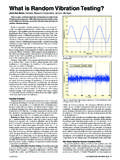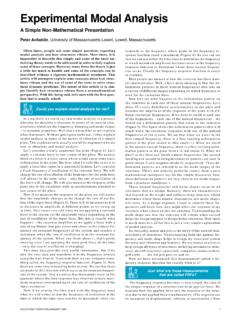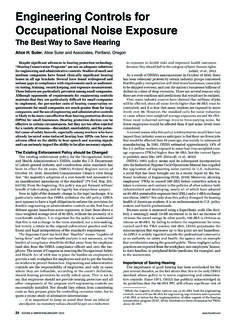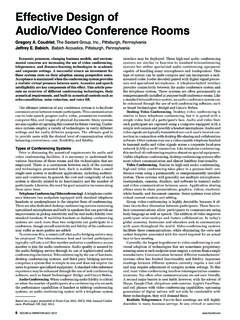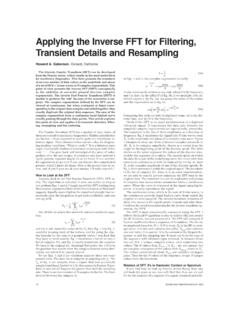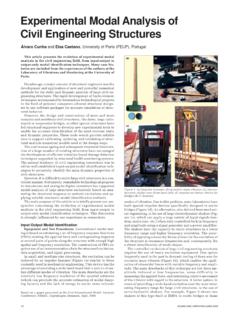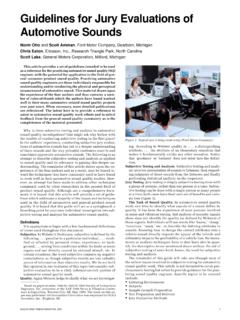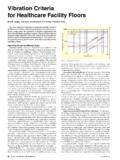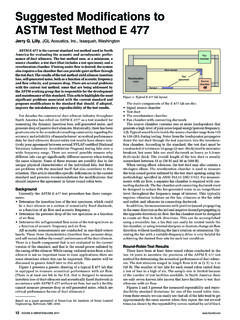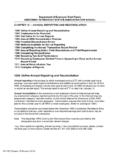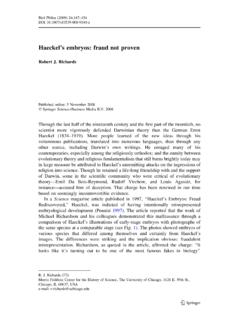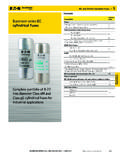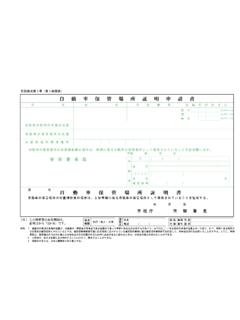Transcription of Recent Trends in Porous Sound-Absorbing Materials
1 sound & VIBRATION/JULY 2010 Sound-Absorbing Materials absorb most of the sound energy striking them, making them very useful for the control of noise. They are used in a variety of locations close to sources of noise, in various paths, and sometimes close to receivers. Although all Materials absorb some incident sound , the term acoustical ma-terial has been primarily applied to those Materials that have been produced for the specific purpose of providing high values of absorption. The major uses of absorbing Materials are almost invariably found to include the reduction of reverberant sound pressure levels and, consequently, the reduction of the reverbera-tion time in enclosures, or rooms. A wide range of Sound-Absorbing Materials exist.
2 In the 1970s, public health concerns helped change the main constituents of Sound-Absorbing Materials from asbestos-based Materials to new synthetic fibers. Although, these new fibers are much safer for human health, more recently, issues related to global warming may increase the use of natural fibers instead of synthetic and vibration are of concern with many mechanical sys-tems, including industrial machines, home appliances, vehicles, and Noise and vibration can also be used as the source of signals for machinery diagnostics and health monitoring, although this topic will not be discussed ,5 Once noise and vibration sources have been identified, the noise and vibration of machinery can be reduced by the use of vibration isolation, barriers, Sound-Absorbing Materials .
3 Machine enclosures or by cabin enclo-sures used to protect passengers in the case of aircraft or ,7 Sound-Absorbing Materials should always be used in conjunction with barriers and inside enclosures to improve their Sound-Absorbing Materials have been used increasingly in the construction of aircraft, spacecraft and ships because of their low weight and effectiveness when used correctly. This trend is driven by demands for higher load capacity and reduced fuel consump-tion for cars, trucks and aerospace structures. The optimum design of vibro-acoustical systems can be achieved through a variety of methods including statistical energy analysis (SEA).9In the last 40 to 50 years, the use and variety of available spe-cialized Sound-Absorbing Materials has increased greatly.
4 This has been due mainly to both improve technology and public concern about noise in everyday life. Architects and acoustical engineers now have a wide choice of Sound-Absorbing Materials that not only provide the desired acoustical properties, but also offer an extremely wide variety of colors, shapes, sizes, light reflectivity, fire ratings, and methods of attachment to say nothing of the costs of purchase, installation, upkeep, the 1970s, a series of events related to public health concerns made makers of Sound-Absorbing Materials change the main con-stituents of their products from asbestos-based Materials to new synthetic fibers. These new fibers are much safer for human health. More recently, issues related to global warming caused by the emis-sion of greenhouse gases into the atmosphere by industrial manu-facture of Materials may change the acoustical Materials market.
5 The production of synthetic Materials contributes to the emission of carbon dioxide (mostly from power plants and transportation), methane, and nitrous oxide. Thus, the total set of greenhouse gas emissions caused directly and indirectly by material production affects its carbon footprint, which may become increasingly impor-tant in future world trade considerations. Moreover, the concept of green building Materials is used in practice in several European countries. In addition, public awareness and concern about the negative effects of pollution has led consumers to favor environ-mentally friendly Materials , less contaminating processes, and recycled products. Therefore, it is important to increase research on acoustical Materials based on renewable resources that can lead to viable alternatives to conventional Materials for current and future ,11In addition, Recent advances in material science, chemistry, and nanotechnologies are producing significant improvements in the design, production, and performance of acoustical Materials .
6 These advances include the use of natural fibers, bio-based polymers, recycled and surplus Materials , Porous metals, new composites, and smart absorbing MaterialsSound- absorbing Materials absorb most of the sound energy striking them and reflect very little. Therefore, Sound-Absorbing Materials have been found to be very useful for the control of noise. They are used in a variety of locations: close to sources of noise (close to sources in electric motors, for example), in various paths (above barriers), and sometimes close to a receiver (inside earmuffs).A wide range of Sound-Absorbing Materials exist; they provide absorption properties dependent upon frequency, composition, thickness, surface finish, and method of mounting.
7 However, Materials that have a high value of sound absorption coefficient are usually Porous absorbing material is a solid that contains cavities, channels or interstices so that sound waves are able to enter through them. It is possible to classify Porous Materials according to their availability to an external fluid such as air. Figure 1 shows a schematic cross-section of a Porous solid material . Those pores that are totally isolated from their neighbors are called closed pores. They have an effect on some macroscopic properties of the material such as its bulk density, mechanical strength and thermal conductivity. However, closed pores are substantially less efficient than open pores in absorbing sound energy.
8 On the other hand, open pores have a continuous channel of communication with the external surface of the body, and they have great influence on the absorption of sound . Open pores can also be blind (open only at one end) or through (open at two ends). A practical conven-tion is used to make a distinction between porosity and roughness, which assumes that a rough surface is not Porous unless it has irregularities that are deeper than they are absorbing Materials can be classified as cellular, fibrous, or granular; this is based on their microscopic configurations. Po-rous Materials are characterized by the fact that their surfaces allow Recent Trends in PorousSound- absorbing MaterialsJorge P.
9 Arenas, University Austral of Chile, Valdivia, ChileMalcolm J. Crocker, Auburn University, Auburn, AlabamaFigure 1. Schematic cross-section of a Porous solid material (adapted from Ref. 12).Closed poresThrough poresOpen poresBlind Materials REFERENCE ISSUE 13sound waves to enter the Materials through a multitude of small holes or openings. Materials made from open-celled polyurethane and foams are examples of cellular Materials . Fibrous Materials consist of a series of tunnel-like openings that are formed by in-terstices in material fibers. Fibrous Materials include those made from natural or synthetic fibers such as glass and mineral In addition, a Porous absorbing material can also be granular.
10 Con-solidated granular Materials consist of relatively rigid, macroscopic bodies whose dimensions exceed those of the internal voids by many orders of magnitude (agglomerates). Unconsolidated materi-als consist of loosely packed assemblages of individual particles (aggregates). Granular absorbing Materials include some kinds of asphalt, Porous concrete, granular clays, sands, gravel, and ,15 So the acoustical properties of granular Materials are an important factor in controlling outdoor sound 2 shows the three main types of Porous sound absorbing Materials , their typical microscopic arrangements and some of the physical models used to describe their absorbing a Porous material is exposed to incident sound waves, the air molecules at the surface of the material and within the pores of the material are forced to vibrate and, in doing so, lose some of their original energy.
